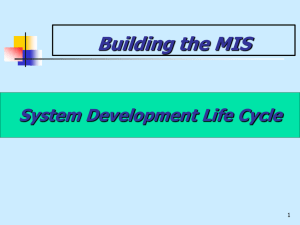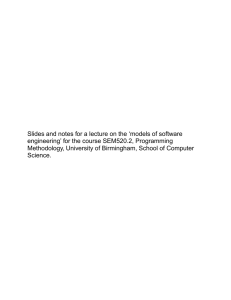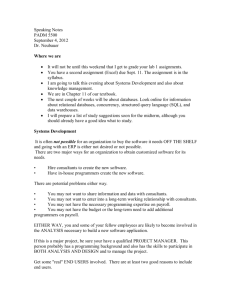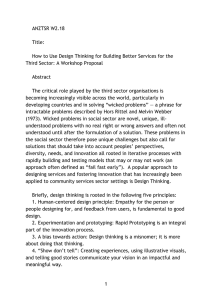Alternatives to the SDLC
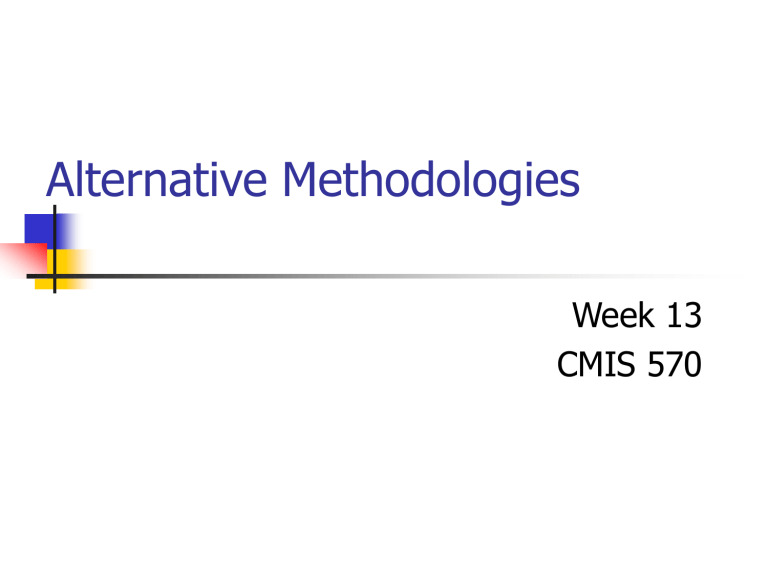
Alternative Methodologies
Week 13
CMIS 570
Our Plan
TONIGHT:
Alternative methods
RAD, Developmental prototyping, Spiral
Approach, XP, UP
Alternative Development
Methods
Ch 17
SDLC
Linear, sequential flow of activities requirements design construction…
Alternative Development
Methods
Reasons SDLC may not always be practical or ideal:
Requirements can’t be completely specified
“new-thinking” requirements
innovative, creative application
Technology is new
associated technical uncertainties and learning associated uncertainty in user requirements
Alternative Development
Methods
Rapid Application Development
Risk management
Joint Application Design
Tool Based development
Software Reuse
Developmental prototyping
Spiral Approach
Extreme Programming
Reasons for Slow Development
Rework
Using the wrong software
Not meeting minimum quality standards
Shifting requirements and project changes
Improper tools and techniques
Cost of Change in Each Project Phase
Figure 13-1
What is RAD?
Collection of development approaches, techniques, tools, and technologies, proven to shorten development schedules
Perspective
Sequential vs. iterative approaches
Project characteristics important in determining approach
RAD Techniques
Collection of guidelines used to help an analyst complete system development activities
Risk management
JAD
Tool-based development
Software reuse
Risk Management
Systematic process of identifying and mitigating software development risks
Principles of risk management
Most risks can be identified if specific attention is directed to them
Risks appear, disappear, increase, and decrease as the development process proceeds
Small risks should be monitored and large risks mitigated
Every project should use risk management
Steps in Risk Management
From Figure 13-10
Identify project risks
Estimate risk outcomes & probabilities
Prioritize risks
Develop & implement mitigation strategies
Project completed
JAD
Shortens development time by including all key decision makers
Can be incorporated into any development approach
Well suited to iterative development approaches
JAD Sessions
Used to expedite the investigation of systems requirements
Seeks to compress fact-finding, modeling, policy formation, and verification activities into a shorter time frame
Critical factor is to have all important stakeholders present
JAD Facilities
Generally conducted in special room
Limits interruptions
May be off-site
Resources
Overhead projector, white board, flip charts, and work material
Electronic support
CASE Tools
Group support systems
High-Tech JAD Facility
Figure 4-15
Tool-Based Development
Chooses tool(s) that best match system requirements and doesn’t develop any requirements not easily implemented with selected tool(s)
System limited by tool
No one tool is best for all development approaches
Software Reuse
Mechanism that allows software used for one purpose to be reused for another
Possible time savings
Effort required to identify reusable software
Effort required for modification
Extent to which software must be repackaged
Developmental Prototyping
Approach
Developmental Prototype
A prototype system that is not intended to be thrown away
Becomes all or part of the final system
As opposed to a “discovery prototype”
Used to discover or refine system requirements or design parameters
Disposable – not intended to become part of final system
Developmental Prototyping
Approach
When to use this approach?
When some of the following:
Some requirements cannot be fully specified independent of detailed design
Technical feasibility for some functions is unknown or uncertain
Prototype development tools are powerful enough to create fully functional systems
NOTE: DP approach works best when most of the requirements are understood up front.
Developmental Prototyping
Approach
Two Types of DP Approaches:
Approach 1:
Develop simple base prototype
Then, add features in subsequent development phases
Approach 2:
Develop a series of independent prototypes
Later, combine them to form complete system
Spiral Approach
Spiral Approach
An iterative development approach in which each iteration may include a combination of planning, analysis, design, or implementation steps
Incorporates Development Prototyping, but is a more radical departure from traditional
SDLC
Spiral Approach
In the initial planning stage (at the center of the spiral):
Feasibility study
High-level user requirements survey
Generation of implementation alternatives
Choice of overall design and implementation strategy
Gather just enough info to begin developing the first prototype
Spiral Approach
A set of system features is implemented in each prototype
For each prototype, development follows a sequential (SDLC-like) path through:
Analysis
Design
Construction
Testing
Integration with previous prototype
Planning for next prototype
Spiral Approach
Strategies for deciding which features to implement in early vs. later prototypes:
May do “must haves” and “should haves” in earlier prototypes
Leaving “nice to haves” for later prototypes
May include heavily-used functions in early prototypes
e.g., data entry and data retrieval functions
May include uncertain or poorly defined user requirements in early prototypes
Why?
Spiral Approach
Benefits:
High parallelism
Many opportunities to overlap activities among prototyping cycles
High user involvement
Frequent and continual user participation, as they are involved in multiple prototyping cycles (planning, analysis, testing)
Steady resource commitment
Resource consumption more evenly spread out
Frequent product delivery
With good planning and decisions on features to be incorporated in early prototypes, early prototypes can be rolled out to the user as working versions
Spiral Approach
Drawbacks:
More complex to manage
More activities occur in parallel
More people working on the project at earlier stages
Rework more likely
Because not all analysis and design occurs before construction
Quality and maintenance may suffer
Design decisions that may seem optimal when looking at a portion of the system may be less than optimal when looking at the entire system
As modifications and enhancements are made, system typically becomes less efficient, less reliable, more difficult to maintain
Extreme Programming (XP)
Rapid development approach focused on creating user stories, delivering releases of a system, and quickly testing
Developed by Kent Beck in 1990’s
Borrows heavily on earlier development approaches
Extreme Programming System Development
Approach
Figure 17-7
XP Principles and Techniques
Continuous automated testing
Continuous integration
Heavy user involvement
Team programming
Specific attention to human interactions and limitations
When to Use XP
Small development teams (12 or less)
Talented development personnel with broad range of skills
Limited scope of projects
Stand-alone
New systems
Minimal interface to legacy system
Extensive use of high-quality OO development and testing tools
Comparison of Traditional, Spiral, and XP
Development
Figure 17-8
Oracle Designer ?
